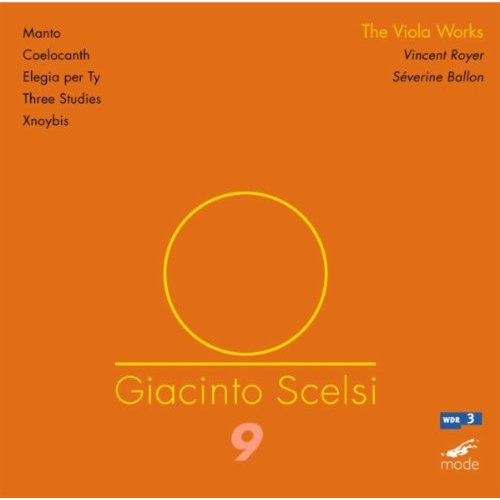
Performers: Vincent Royer, viola & voice
Composer: Giacinto Scelsi
Label: mode records
ASIN: mode 231
Format: Audio CD
Release Date: 19 Jun 2011
Shop: Amazon .de .com .fr
Vincent Royer, viola & voice
1. Manto (1957) First recording with male voice (10:23 )
2. Coelocanth (1955) (10:51)
3. Elegia per Ty (1958) Séverine Ballon, cello (10:28)
4. Three Studies* (1956) First recording (13:43 )
5. Xnoybis* (1964) First recording (11:21)
Volume 9 of Mode’s Scelsi Edition is devoted to the first complete recording of Giacinto Scelsi’s works for viola solo and duo.
• Manto was a prophet in ancient Greece. Scelsi translated her oracle maxims into cryptic phonemes which the viola player has to sing simultaneously in the third movement. In Manto, the sound of the viola is expanded and explored via experimental playing techniques. This is the first recording of the third movement.
• In Xnoybis, Scelsi’s exploration “into the inside of the sound” is taken to its extreme. A central tone, variously colored and surrounded, moves in microtonal steps — no melody in the traditional sense, but a sole wandering sound. This is the first recording of the viola version in a transcription by Vincent Royer.
• Elegia per Ty for viola and violoncello is Scelsi’s tender rememberance of his former wife Dorothy (nicknamed “Ty”). It is among his most important chamber works.
• Coelocanth and the Three Studies belong to Scelsi’s earlier style of composing. Concise motivic gestures are developed by improvisation. These expressive, virtuoso pieces are overwhelming in their ecstatic ferocity. This is the first recording of the “Three Studies”.
• Violist Vincent Royer is one of the most outstanding performers of contemporary music today. Mr. Royer, who was born in France but now lives in Cologne, Germany, is among a handful of musicians who have truly mastered the works of the Spectral composers, such as Gerard Grisey. In his hands, these challenging and complex works give way to new forms of musical expression that are mysterious, powerful and filled with beautiful colors. A key to his deep understanding of new music is his close collaboration with living composers, like Horatiu Radulescu and Tristan Murail, two important composers with whom Mr. Royer has enjoyed a close working relationship.
• Liner notes by Friedrich Jaecker and Sharon Kanach.
For those who think that improvisation, extended techniques and tonal explorations belong to the realm of avant-garde jazz, I can recommend a close listen to this fantastic album of modern classical music, composed by Giacinto Scelsi and performed by Vincent Royer on viola and Séverine Ballon on cello. I review classical music rarely, and when I do, I seem to have a preference for string duos, as with the equally recommendable "Manto and Madrigals" by Zehetmair and Killius.
This album is quite unique in the sense that it is the first recording of the complete works for viola and cello. It consists of five pieces, ranging from the experimental "Manto", in which Royer even sings, to the more restrained and austere "Coelanth". "Elegia per Ty", dedicated to his former wife, is the most gripping piece, with cello and viola playing in a tender embrace, full of sadness and controlled tension.
There are no themes so to speak of, just soundscapes, composed with an incredible sense of minute development and sense for effect, and performed with an uncanny precision. The end result is incredibly mesmerising and compelling.
Fantastic music. Listen to the excerpt below and judge for yourselves.
Mode’s commitment to the challenge of recording the complete works of Giacinto Scelsi is extraordinary. Sales of such austere, difficult music can be relatively small, yet this is already volume nine in the series. The disc is devoted to the Italian composer’s works for viola, though the Elegia per Ty involves a cello as well, and in one of the movements of Manto, the violist has to sing as well as play. Xnoybis, from 1964, was originally written for violin at a time when Scelsi’s music was at its most extreme and concerned with exploring the implications of single sounds. All of the other works here were composed in the 1950s, when a continuous line, rather than a single pitch, was the focus of his attention. Coelocanth from 1955, named after the famous “living fossil” fish, and the Three Studies from the following year, are perhaps the most conventional works here; both are based on incantation-like melodies. The demands placed on the soloist are immense, often requiring several different playing techniques to be used simultaneously, but Vincent Royer’s performances are immaculate.
guardian.co.uk, Thursday 1 Sep 2011